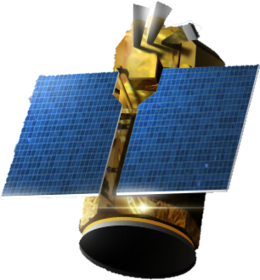 Artist's concept of Formosat-5 | |
| Mission type | Earth observation |
|---|---|
| Operator | NSPO |
| COSPAR ID | 2017-049A |
| SATCAT no. | 42920 |
| Website | Formosat-5 |
| Mission duration | Planned: 5 years Elapsed: 7 years, 2 months, 30 days |
| Spacecraft properties | |
| Manufacturer | NSPO |
| Launch mass | 475 kg (1,047 lb)[1] |
| Dimensions | 1.6 × 2.8 m (5.2 × 9.2 ft)[1] |
| Start of mission | |
| Launch date | 24 August 2017, 18:51 UTC[2] |
| Rocket | Falcon 9 FT |
| Launch site | Vandenberg SLC-4E |
| Contractor | SpaceX |
| Orbital parameters | |
| Reference system | Geocentric |
| Regime | Sun-synchronous |
| Semi-major axis | 7,101.4 km (4,412.6 mi) |
| Eccentricity | 0.0009348 |
| Perigee altitude | 716.6 km (445.3 mi) |
| Apogee altitude | 729.9 km (453.5 mi) |
| Inclination | 98.2892° |
| Period | 99.25 minutes |
| Epoch | 25 August 2017, 12:30:14 UTC[3] |
FORMOSAT programme | |
Formosat-5 (Formosa Satellite 5; Chinese: 福爾摩沙衛星五號) is the first Earth observation satellite manufactured and operated solely by the National Space Organization, the national civilian space agency of Taiwan. The satellite was launched from a Falcon 9 rocket on 24 August 2017, and placed into a Sun-synchronous orbit at an altitude of about 720 km. Formosat-5 can capture color and more detailed monochrome images, along with measuring the ionosphere plasma's properties.
- ^ a b "Space Programs: FORMOSAT-5: Satellite". National Space Organization. Archived from the original on 26 August 2017. Retrieved 25 August 2017.
- ^ Clark, Stephen (25 August 2017). "Taiwanese satellite rides SpaceX rocket". Spaceflight Now. Archived from the original on 9 August 2018. Retrieved 25 August 2017.
- ^ "FORMOSAT-5: TLE". Space-track.org. 25 August 2017. Retrieved 25 August 2017.